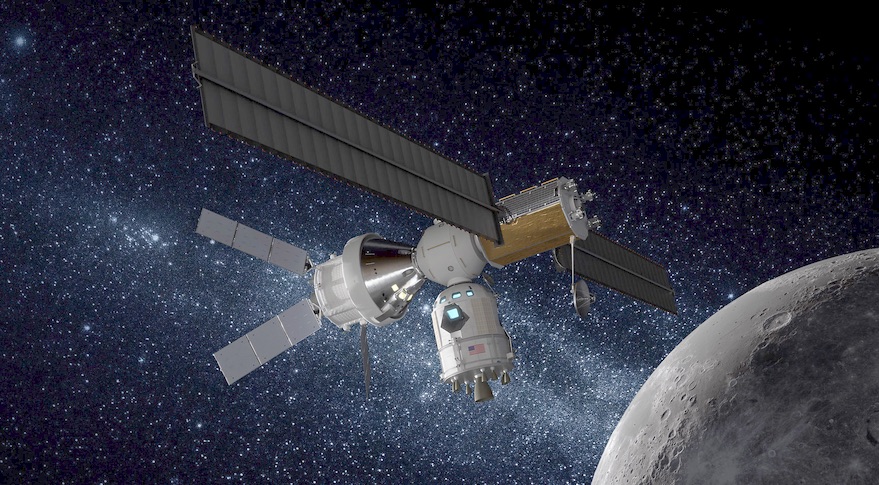
WASHINGTON — In order to meet the goal of landing humans on the moon in 2024, NASA needs to get one element of its proposed lunar Gateway on contract in the near future so it will be ready in time.
NASA’s latest plans for getting humans back to the surface of the moon involve the development of a scaled-down or “minimal” Gateway in a near-rectilinear halo orbit around the moon. That initial outpost, which can be scaled up later for future missions, would consist of a Power and Propulsion Element (PPE) and a “mini-hab” or “utilization” module that would have docking ports and serve as a habitat for visiting crews.
NASA issued a solicitation for the PPE last year and is currently evaluating several proposals from industry, likely based on current commercial satellite buses that will be equipped with high-power electric propulsion systems. NASA could issue awards for the PPE as soon as this month, although agency officials have said recently that the PPE awards would come this summer.
Less clear is the plan for the utilization module. Several companies are currently working on prototypes of habitation modules as part of NASA’s Next Space Technologies for Exploration Partnerships, or NextSTEP, program. Such concepts will be the likely basis for the module, with modifications to incorporate docking ports.
To meet NASA’s schedules, the module will likely be based on existing designs, such as International Space Station modules. “If you leverage an existing capability, and the one I throw out there is a station element,” said Peter McGrath, director of global sales and marketing for space exploration at Boeing, “you can easily build something.”
McGrath and other panelists during a session at the Humans to Mars Summit here May 15 said they believed a utilization module based on existing designs could meet NASA’s schedule. Mike Fuller, a business development manager for NASA programs at Northrop Grumman, said the company is looking at designs based on ISS modules, with a diameter of 4.5 meters, and Cygnus cargo spacecraft modules with a diameter of 3 meters.
“If you really want to go minimalist, a three-meter pressure vessel would be relatively easy for us to produce on the current production line,” he said.
To have the module in place in lunar orbit prior to the lunar landing, though, NASA needs to get a design under contract within the next year, they said. “If you want to get the habitat on schedule, you’ve got to move,” McGrath said, emphasizing the need to base the module on existing designs. “If you add a big development curve on it, or wait a year and a half to procure it, you’re going to have a hard time, I think, getting to ’24.”
He noted that a typical development timeline for an item like the utilization module is three to four years. “So if you’re talking about ’24 and you want to get this up in ’23, that puts you in about a yearlong window of opportunity,” he said. Using heritage designs and hardware would make that schedule less aggressive.
“I think we’d all say that, technically, we can do it,” said Neeraj Gupta, director of advanced development at Sierra Nevada Corporation. “Contracting mechanisms, and the speed of getting all these things awarded and solidified, that’s the thing I think that’s the tallest pole.”
Industry officials didn’t have a strong preference for how NASA should procure the module. NASA is using less conventional contracting mechanisms for some parts of its exploration architecture, particularly those elements like the PPE that leverage commercial capabilities.
Whatever the approach, companies want NASA to press ahead with its procurement of the module as soon as possible. “The sooner we can get on contract, the better,” Gupta said.
“Yesterday would have been good,” Fuller said.
https://spacenews.com/industry-wants-nasa-to-move-ahead-quickly-on-gateway-module/
2019-05-20 04:20:44Z
52780300290144
Tidak ada komentar:
Posting Komentar